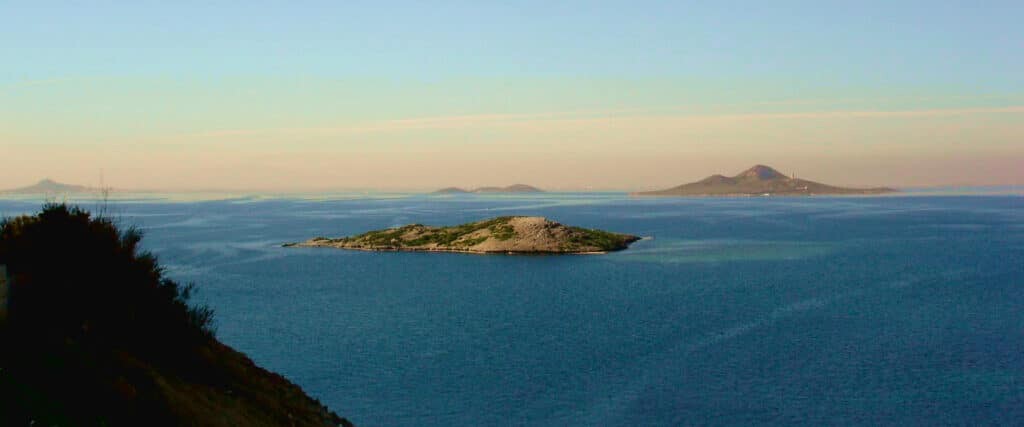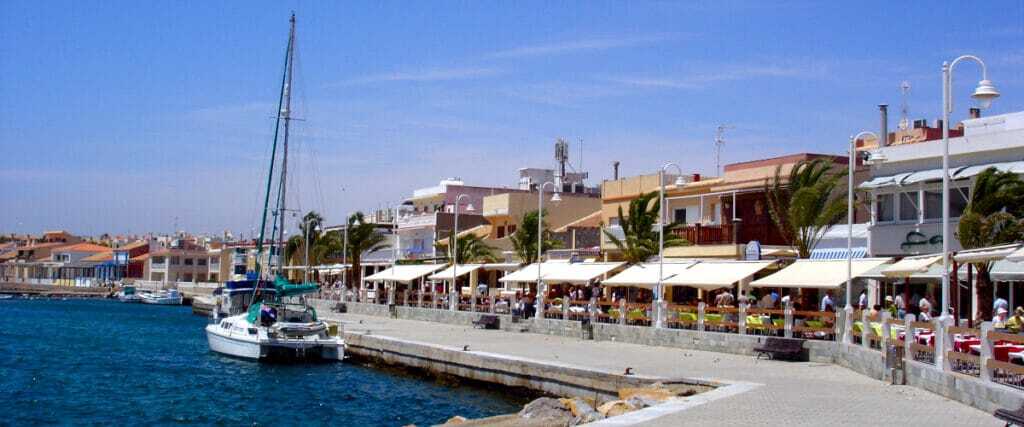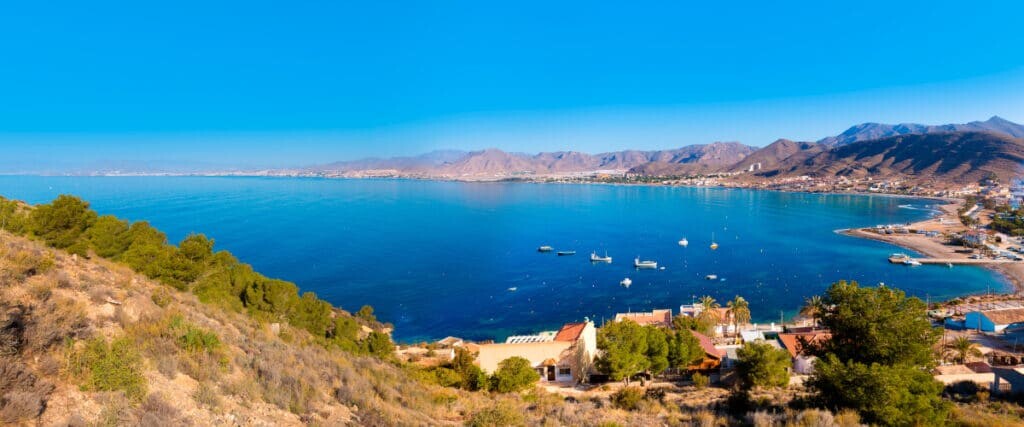

WHY DE COSTA CALIDA?
The Costa Cálida, which literally means ‘warm coast’, is the coastal area of the region of Murcia – one of the 17 autonomous regions that makes up Spain – 252 kilometers long and an alternation of long, white or golden sandy beaches with steep rocks falling from the sea and sheltered rocky coves.
And the interior is a game between mountainous and rolling, sometimes natural and rugged, sometimes man-made. And especially in January and February when the almond trees are in bloom, it becomes magical. Entire valleys are transformed into one white-pink landscape.
But the interior is also very fertile. Thanks to an ingenious system of irrigation canals, the Moors transformed unusable wetlands into green fields.
If you see a Spanish truck on Belgian or Dutch roads, you often see that it comes from Murcia.
The coast runs from San Pedro del Pinatar in the north to Águilas in the south.
And is also sometimes called the Costa with the two seas: on the one side the Mar Menor, literally small sea but the largest inland sea in Europe and on the other side the Mediterranean Sea.
FOR WHOM IS THE COSTA CÁLIDA IDEAL?
First step when buying a house in Spain? Find out where you feel at home!
Well, for whom is the Costa Cálida the ideal place to spend a holiday or to move to Spain?
In brief? For the doers. For golfers, divers, surfers, kiters. But also for walkers and cyclists. For nature and bird lovers. For seekers of culture with large C.
Costa Cálida, between the Costa Blanca, Alicante and Almeria, Costa de Almeria.


SAN PEDRO DEL PINATAR – THEY PAY IT
We start in the north in San Pedro del Pinatar and Lo Pagán at one of the many natural parks in Murcia: Parque Regional de las Salinas y Arenales.
You can spot flamingos all year round. Lo Pagán is best known for the medicinal open air mud baths recommended for all types of skin conditions and forms of rheumatism. And it is even more ideal to combine the mud baths with salt water baths in the Mar Menor. You can go to various Spa hotels along the coast for this, but you can also do the low budget yourself.
Remove a handful of mud from the Salinas, rub it in, dry it and rinse it back in the Mar Menor. The best scrub out there! Life on the Mar Menor can be that simple.
RESTAURANT TIP
Hungry from all that scrubbing? How about fish in salt crust, with salt straight from the Salinas of San Pedro? You will find restaurant Mar de Sal at the very end of the Salinas salt production. Our favorite restaurant is La Venezuela in Lo Pagan.


THE MANGA STRIP
The inland sea is then separated from the Mediterranean by a narrow spit of land of 22 km long, La Manga strip. This area is very popular with water sports enthusiasts because of its many harbors, sheltered bays and anchorages. Very few waves in the morning, but due to the shallow (7m) and warm seawater in the summer, strong thermals and wind in the afternoon. You will therefore see plenty of kite surfers in the late afternoon.
It is also paradise for children. The water is warm, shallow and only slopes very slowly so they can play here peacefully and safely.


MINOR SEA
The largest seaside resort on the Mar Menor is Los Alcázares or LA for the insiders. This idyllic place is known for its bathhouses with long ramps leading into the sea, chosen by the Arab kings as their summer palaces.
One of the remaining gems is Hotel Balneario La Encarnación. The courtyard is especially worth seeing. All kinds of deep green and colorful hanging plants hang down here. From Santiago de la Ribera you can cross the Mar Menor again to the largest marina of the Mar Menor, Thomas Maestre. Our advice is, cross at lunchtime because in the marina you will find a very wide choice of restaurants and bars. Or sporty? At the terminal of the boat you can rent a bicycle and cycle up and down the entire headland or strip.
In short, the Mar Menor is the place to be for water enthusiasts.
Swimming, sailing, boating, diving, kiting it’s all possible.
And ideal for the kids to play and float in because the Mar Menor is very shallow and only gets deeper very gradually. After 10 to 15 meters, an adult is in the water approximately up to his hips. Ideal for catching up with the neighbors and cooling off in the meantime. Because that’s what the Spaniards do around 8 pm in the summer, get into the water and have a chat!


CAPE OF STICKS
South of the Mar Menor, at the start of the La Manga strip, lies Murcia’s most charming fishing village, Cabo de Palos. With a large weekly market, a pleasant harbor, numerous restaurants, a real bakery and a fish shop that is highly recommended. You have the best view from the lighthouse. Cabo de Palos also has one of the two largest diving centers in Spain and a true underwater nature reserve Islas Hormigas and Isla Grosa.


CALANQUE


CARTAGENA


THE AZOHIA
RESTAURANT TIP


MAZARRON – EAGLES
The last 2 towns of the Costa Cálida are Mazarrón, a tourist center with excellent amenities and animated nightlife and the Ciudad Encantada. A special landscape of sandstone sculpted by time and wind.
En Águilas, a former Roman fishing port and an important mining center in the 19th century.
At the time, iron, lead and silver from the nearby mines were loaded onto ships at the Hornillo quay.
Today best known for its carnival, which is still celebrated extensively here.